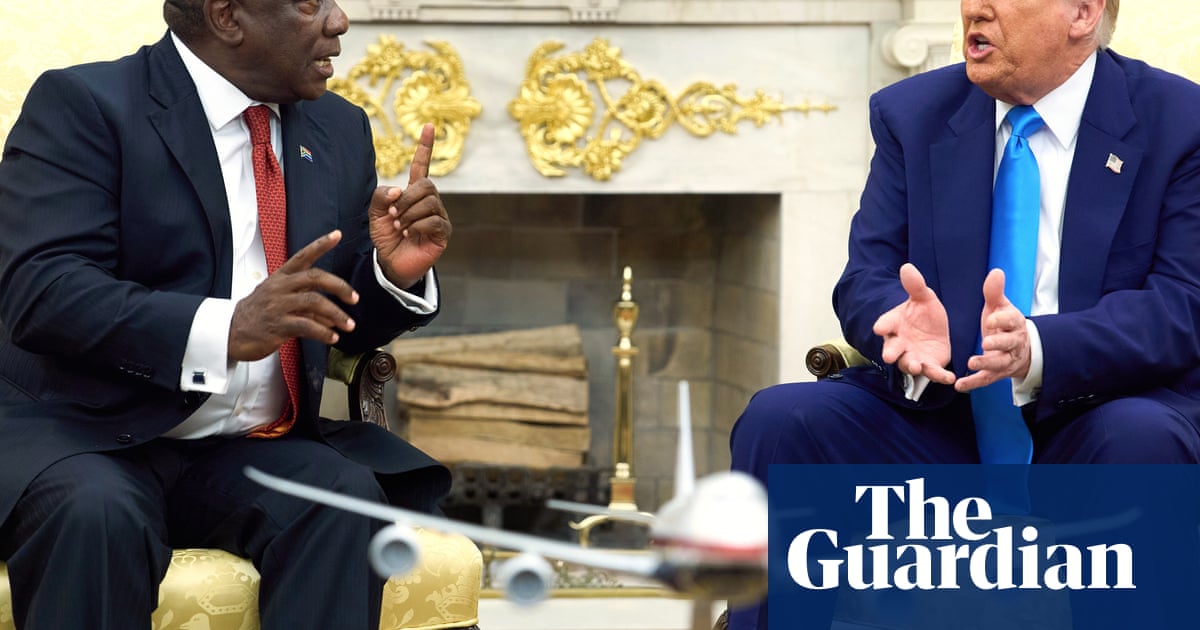Donald Trump ambushed the South African president, Cyril Ramaphosa, by playing him a video that he falsely claimed proved genocide was being committed against white people under “the opposite of apartheid”.
The hectoring stunt on Wednesday set up the most tense Oval Office encounter sinceTrump’s bullying of Volodymyr Zelenskyy in February. But Ramaphosa – who earlier said that he had come to Washington to “reset” the relationship between the two countries – refused to take the bait and suggested that they “talk about it very calmly”.
Trump has long maintained that Afrikaners, a minority descended from mainly Dutch colonists who ruledSouth Africaduring its decades of racial apartheid, are being persecuted. South Africa rejects the allegation. Murder rates are high in the country and the overwhelming majority of victims are Black.
What began as a convivial meeting at the White House, including lighthearted quips about golf, took a sudden turn when Ramaphosa told Trump there is no genocide against Afrikaners.
Trump said: “We have thousands of stories talking about it,” then ordered his staff: “Turn the lights down and just put this on.”
Sitting next to Trump before the fireplace, Ramaphosa forced a smile and turned to look at a big TV screen as Trump’s South Africa-born billionaire ally Elon Musk, JD Vance, the defence secretary Pete Hegseth and diplomats and journalists from both countries looked on.
The video included footage of former South African president Jacob Zuma andfirebrand opposition politician Julius Malemasinging an apartheid-era struggle song called “Kill the Boer”, which means farmer or Afrikaner, as supporters danced.
Ramaphosa quietly but firmly pushed back, pointing out that the views expressed in the video are not government policy.
There was also footage that Trump claimed showed the graves of more than a thousand white farmers, marked by white crosses. Ramaphosa, who had mostly sat expressionless, occasionally craning his neck to look, said he had not seen that before and would like to find out what the location was.
Trump then produced a batch of newspaper articles that he said were from the last few days reporting on killings in South Africa. He read some of the headlines and commented: “Death, death, death, horrible death.”
Ramaphosa acknowledged there is crime in South Africa and said the majority of victims are Black. Trump cut him off and said: “The farmers are not Black.”
The conspiracy theory of a white genocide has long been a staple of the racist far right, and in recent years has been amplified by Musk and rightwing media personality Tucker Carlson.
Trump kept returning to the theme during Wednesday’s televised meeting. He said: “Now I will say, apartheid: terrible. That was the biggest threat. That was reported all the time. This is sort of the opposite of apartheid.
“What’s happening now is never reported. Nobody knows about it. All we know is we’re being inundated with people, with white farmers from South Africa, and it’s a big problem.”
He added: “They’re white farmers, and they’re fleeing South Africa, and it’s a very sad thing to see. But I hope we can have an explanation of that, because I know you don’t want that.”
But Ramaphosa maintained an even tone, observing: “We were taught by Nelson Mandela that whenever there are problems, people need to sit down around the table and talk about them. And this is precisely what we would also like to talk about.”
The meeting came days after around50 Afrikaners arrived in the US to take up Trump’s offer of “refuge”. Trump made the offer despite the US having halted arrivals of asylum seekers from most of the rest of the world as he cracks down on immigration.
Relations between the countries are at their lowest point since the end of apartheid in 1994. The US has condemned South Africa’s case accusing Israel of genocide in Gaza at the international court of justice, slashed aid, announced 31% tariffs andexpelled the South Africa ambassador for criticising Trump’s Make America great again (Maga) movement.
But the biggest bone of contention has been a South African land-expropriation law signed in January that aims to redress the historical inequalities of white minority rule. Ramaphosa denied that the law will be used to arbitrarily confiscate white-owned land, insisting that all South Africans are protected by the constitution.
But Trump falsely asserted: “You do allow them to take land – and then when they take the land, they kill the white farmer, and when they kill the white farmer, nothing happens to them. …
“You’re taking people’s land away from them and those people in many cases are being executed. They’re being executed and they happen to be white.”
Ramaphosa arrived at the White House with agriculture minister John Steenhuisen, who is white,two of South Africa’s top golfers, Ernie Els and Retief Goosen, and the country’s wealthiest person, Johann Rupert, in a bid to woo the golf-loving president. All weighed in during the Oval Office meeting and seemed to be well-received by Trump.
Rupert said South Africa needs technological help in stopping deaths in the country, which he said were not just of white farmers but across the board. “We have too many deaths ... It’s not only white farmers, it’s across the board, and we need technological help. We need Starlink at every little police station. We need drones,” Rupert said.
South Africa will reportedly offer Musk, who was born in the country, a deal to operate his Starlink satellite internet network in the country. The Tesla and SpaceX boss has accused Pretoria of “openly racist” laws, a reference to post-apartheid Black empowerment policies seen as a hurdle to the licensing of Starlink.
South Africa is one of the most unequal societies in the world. White people make up 7% of the country’s population but own at least half of South Africa’s land. They are also better off economically by almost every measure.
